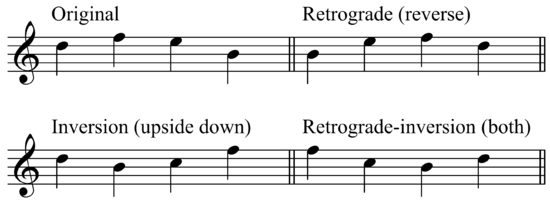MUSIC THEORY - motifs
A theme most of the time has multiple motifs that play an important role. The word is originated from the Latin word ‘motus’ for movement. You got two sorts of motifs; an independent and one that depends of the theme. When strict motivic repetition is used it means that the same tone and rhythmic structure are being persisted, but modified motivic repetition is more usual:
- imitation = strict repetition with the motive in different voices
- reharmonization = the change of harmony around the motive
- embellishment = one or more notes added to the motif (aa’)
- tonal transposition = transposing while keeping the quality of the interval, but alternating in relation to the key.
- real transposition = keeping the interval distances of the motive
- sequens = a motive that two or more times at the same way is transposed.
- stretto = when motifs overlap in different voices.
There are also changes within the motive;
- the possibility to change the distance of intervals
- inversion or mirror = intervals in opposite direction
- retrograde = turns the motive around, so from behind to the front
- retrograde inversion = from behind to the front with the intervals in opposite direction

Rhythmic;
- augmentation = widen
- diminution = reduce
motivic saturation or juxtaposing is when a lot of the elements are put together, so combined.
developmental repetitions are transformed and most of the times the hardest, but also the most important. It has the possibilities:
- interpolation = the adding of notes that look like an intermediate piece of embellishment
- fragmentation = a part of the motif, often the beginning and repetition of different fragments
intersection and intermovement motivic repetitions to soften the connection between 2 contrasting sections
- linkage = preserving the motivic element, but adjusted to the new musical surroundings
- single interval motives
- octave displacement; most of the times a part of the motive
- hidden motivic repetitions
- motivic nesting; adding motives in motives
- motivic parallelism
an example where you could here the different uses of motifs very clear is Mozart KV333, piano sonate no. 13 in Bmajor
Yours Sincerely @inMusicalTerms
P.s.: check out my collab with other steemit musicians here: https://steemit.com/dsound/@davidfar/20180225t120107080z-a-strange-day-original-music-a-live-steemian-band-from-around-the-world
Hallo,
wat een leuke stukje allemaal over muziek theorie enzo.
leerzaam ook.
Weet je ook dat er veel Nederlands - taligen zijn en dat er een tag #alldutch is en een tag #alldutchenglish?
't zou leuk zijn als je stukken ook onder de Nedersteemers bekend zouden worden.
grt, @vjbasil
You got a 1.37% upvote from @minnowvotes courtesy of @inmusicalterms!